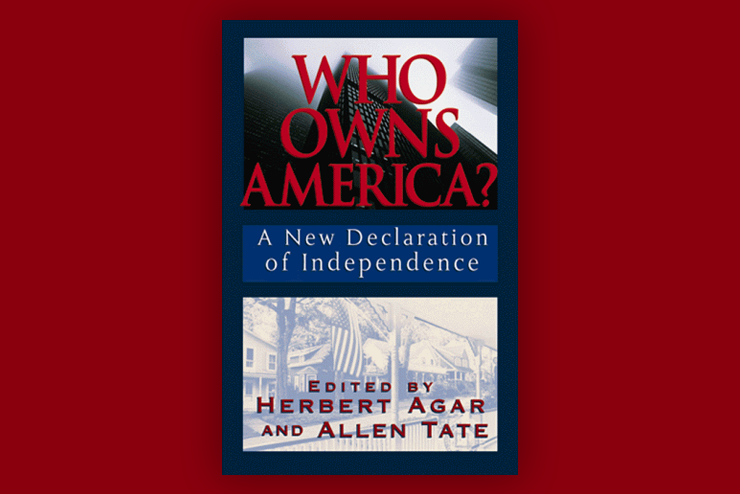First published in 1936 as the nation was still reeling from the Great Depression, Who Owns America? A New Declaration of Independence remains a classic of American political thought and rhetoric.
A collection of 21 essays, edited by the Fugitive-Agrarian Allen Tate and historian Herbert Agar, it was intended in part as a sequel to the better-known I’ll Take My Stand, which preceded it by six years. The earlier collection had focused exclusively on the South and its agrarian traditions, but the Tate-Agar collection expands the polemical range to include the whole of America.
 Moreover, while the emphasis on the Jeffersonian vision of a decentralized union of states and communities rooted in agriculture and small proprietorships is still given pointed emphasis, the central thrust of the key essays in this volume is directed at what the Agrarians and their collaborators had come to regard as the primary antagonist of the Jeffersonian vision: corporate or “monopoly” capitalism.
Moreover, while the emphasis on the Jeffersonian vision of a decentralized union of states and communities rooted in agriculture and small proprietorships is still given pointed emphasis, the central thrust of the key essays in this volume is directed at what the Agrarians and their collaborators had come to regard as the primary antagonist of the Jeffersonian vision: corporate or “monopoly” capitalism.
The argument, reduced to a single thread, runs something like this: Prior to the late 19th-century, America was a republic in the Jeffersonian mold: a republic of small farmers and small businesses, mainly sole proprietorships of various kinds. The ownership of property was widely distributed and it was generally understood that liberty was meaningless outside the context of such ownership, which guaranteed its possessor a degree of social and political autonomy that could not otherwise be achieved.
Without such a widespread dispersal of property, the virile republican ideal which motivated virtually all of the Founding Fathers would not have been possible. Yet this property ideal must be of a particular kind, as one of the book’s essayists, the scholar, poet, and literary critic John Crowe Ransom, argues: “…it must be property which the owner administers, not a paper ownership which does not entail any part in the management.”
It is this mode of ownership which is assumed by the principles written into the Constitution; the “inviolability of the person” rests upon the “inviolability of property.” In the old republic, organic and vigorous communities grew to maturity in their shared understanding of this inviolability.
In the 19th century, the serpent entered the garden in the form of charters of incorporation wedded to the rise of the Industrial Revolution. Incorporation in itself, understood as a legal and social concept, is benign, and has a lineage dating back to the Middle Ages. But in the U.S., with the shift from an economy of production toward an economy of consumption, the very character of “free enterprise” was transformed.
Large companies under the ownership of individuals or families began to adopt the corporate form for a number of reasons, among them, as Richard B. Ransom notes, the “possibility of indefinite expansion, the absence of personal responsibility on the part of the owners, [and] flexibility in the sale, division or aggregation of shares in the enterprise.”
Moreover, as Lyle Lanier argues, the Supreme Court licensed the proliferation of these powerful corporations by its “narrow construction of the interstate commerce clause of the Constitution,” effectively robbing the states (or, for that matter, the federal government) of any significant control over capitalist expansion. By way of monopolies or semi-monopolies, trade associations, holding companies, and various price-fixing combinations, the largest corporations were able to eliminate or absorb smaller, independent enterprises—including family farms.
 Of course, in the 84 years since Who Owns America? was published, capitalism has undergone yet another metamorphosis. The authors do not appear to have anticipated the complete globalization of the economy or the transformation of the American middle classes into dependent shareholders, by way of pension plans, 401(k)s and the like.
Of course, in the 84 years since Who Owns America? was published, capitalism has undergone yet another metamorphosis. The authors do not appear to have anticipated the complete globalization of the economy or the transformation of the American middle classes into dependent shareholders, by way of pension plans, 401(k)s and the like.
Yet, most of their diagnosis remains germane. Their proposed solutions, however, are sometimes questionable. Calls for nationalization of essential industries in the name of the public good conjure up the specter of socialism, however conservative the intent. More interesting is the support given in the book’s essays to locally owned and controlled “cooperative” enterprises—small factories, for example, of “not more than a hundred people” owned and administered by employees but in conjunction with the states in which they are chartered.
One thing is certain: We cannot afford, as conservatives, to imagine that corporate capitalism has anything to do with “free enterprise.” For those who wish to sever themselves from that illusion, Who Owns America? is a fine place to begin.



Leave a Reply